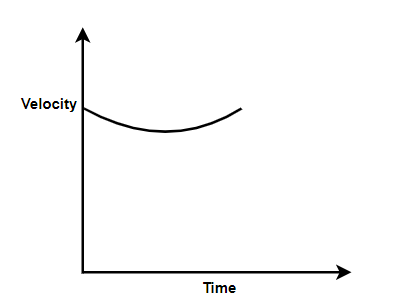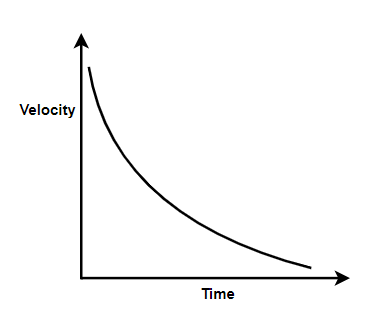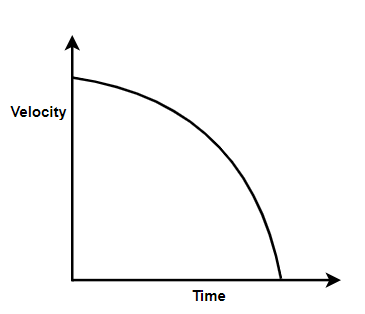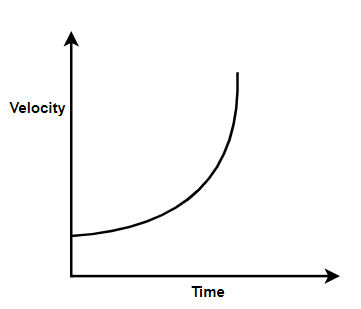
Which graph corresponds to an object moving with a constant negative acceleration and a positive velocity?








Answer
459k+ views
Hint: We are asked to find a graph out of the four given graphs which represents negative acceleration and positive velocity. Thus, we will use our concepts of acceleration, velocity and broadly of motion. Then we will use the ideas of integration and differentiation for picking out the graph.
Complete Step by Step Solution:
Given the case as negative acceleration.
Thus,
Let us take acceleration to be a negative constant.
Now,
We know
Thus, we get
We can write
Thus, we get
But,
Thus, we get
Now,
Rearranging the terms, we get
Now,
Integrating both sides with limits of velocity being
Integrating under these limits, we get
After integration, we get
Where,
After putting the limits, we get
Taking the whole equation equating to distance, we get
Clearly, for this we will get a graph as a velocity-distance graph with velocity curving down with increase in distance.
Hence, we can see that out of the four options,
Additional Information:
For depicting the parts of calculus in a graph, there are two cases.
First case is, we depict the differentiation of a quantity as the slope of the graph.
For example:
If distance is differentiated with respect to time, then we plot distance on the y-axis and time on the x-axis and the slope of the plotted graph shows the value
Then,
The integration of a value is depicted by the area under the curve of the graph.
For example:
If velocity is integrated with respect to time, then we plot velocity on the y-axis and time on the x-axis and the area of the plotted curve shows the value
Note: In this case, we took acceleration as a constant quantity and thus we found out this result. If the acceleration was itself a changing quantity, then the result of integration would be somewhat different and as a result, the graph would also change.
Complete Step by Step Solution:
Given the case as negative acceleration.
Thus,
Let us take acceleration to be a negative constant.
Now,
We know
Thus, we get
We can write
Thus, we get
But,
Thus, we get
Now,
Rearranging the terms, we get
Now,
Integrating both sides with limits of velocity being
Integrating under these limits, we get
After integration, we get
Where,
After putting the limits, we get
Taking the whole equation equating to distance, we get
Clearly, for this we will get a graph as a velocity-distance graph with velocity curving down with increase in distance.
Hence, we can see that out of the four options,
Additional Information:
For depicting the parts of calculus in a graph, there are two cases.
First case is, we depict the differentiation of a quantity as the slope of the graph.
For example:
If distance is differentiated with respect to time, then we plot distance on the y-axis and time on the x-axis and the slope of the plotted graph shows the value
Then,
The integration of a value is depicted by the area under the curve of the graph.
For example:
If velocity is integrated with respect to time, then we plot velocity on the y-axis and time on the x-axis and the area of the plotted curve shows the value
Note: In this case, we took acceleration as a constant quantity and thus we found out this result. If the acceleration was itself a changing quantity, then the result of integration would be somewhat different and as a result, the graph would also change.
Latest Vedantu courses for you
Grade 11 Science PCM | CBSE | SCHOOL | English
CBSE (2025-26)
School Full course for CBSE students
₹41,848 per year
Recently Updated Pages
Master Class 11 Economics: Engaging Questions & Answers for Success

Master Class 11 Business Studies: Engaging Questions & Answers for Success

Master Class 11 Accountancy: Engaging Questions & Answers for Success

Master Class 11 English: Engaging Questions & Answers for Success

Master Class 11 Computer Science: Engaging Questions & Answers for Success

Master Class 11 Maths: Engaging Questions & Answers for Success

Trending doubts
State and prove Bernoullis theorem class 11 physics CBSE

1 ton equals to A 100 kg B 1000 kg C 10 kg D 10000 class 11 physics CBSE

State the laws of reflection of light

One Metric ton is equal to kg A 10000 B 1000 C 100 class 11 physics CBSE

1 Quintal is equal to a 110 kg b 10 kg c 100kg d 1000 class 11 physics CBSE

Difference Between Prokaryotic Cells and Eukaryotic Cells




